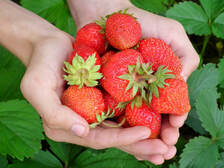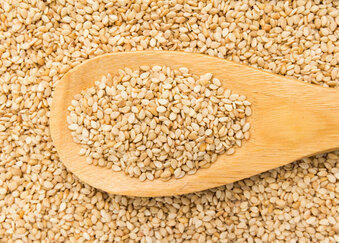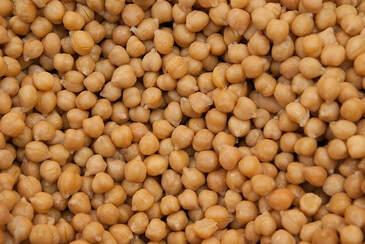 According to the Center for Disease Control and Prevention, nutrient dense foods are those that provide an average of 10% or more daily value per 100 calories of 17 nutrients, including potassium, protein, fiber, iron and calcium. While there are numerous fruits and vegetables that are nutrient dense, there are some in particular that are best in the summertime because they also happen to be very hydrating. Citrus fruits and berries are excellent choices for summer snacking. According to CDC’s nutrient density approach, the healthiest of them all is the strawberry, with a nutrient density score of 17.6. According to the FDA, strawberries have more vitamin C than any citrus fruit, and are also rich in potassium and fiber. As an added bonus, strawberries are a good source of flavonoids, a group of phytonutrients linked to reduced risk of diabetes, heart disease, and some cancers. Strawberries are about 92% water, a proportion similar to that of watermelon; and, because of their electrolyte content, strawberries are an ideal source of hydration on warm days. If you aren’t a fan of eating a portion of plain fresh strawberries, the flavor of strawberries is delicious when sliced pieces are added to your ice water. There are also many healthy summer recipes, both sweet and savory, that contain strawberries, such as the Caprese Salad with Strawberries recipe below! Refreshing Caprese Salad with Strawberries 2 pounds fresh strawberries, stemmed and halved 2 cups bite-sized fresh mozzarella balls (Bocconcini), drained and halved 2 tablespoons extra virgin olive oil 1/3 cup balsamic vinegar 3-4 fresh basil leaves, finely diced Salt, pepper to taste In medium sized bowl, toss strawberries and mozzarella balls with olive oil. Season mixture with salt and pepper. Add basil and toss again. Drizzle balsamic syrup over and around salad. Grind more pepper on top and serve. References:
5 Comments
1/2/2021 8 Comments Healthy Happy New Year RecipeWe’ve made it through the year 2020 and it is time for a new beginning and fresh perspective. Here is a delicious and healthy recipe to help you launch 2021! This vegetarian dish includes protein, fiber, and anti-inflammatory phytochemicals. It is also zesty and satisfying - enjoy!
Spiced Black-Eyed Peas with Coconut Milk - recipe makes 6 servings 2 cups dried black-eyed peas Dash salt 3 tbsp. canola oil 1 large red onion 1 1/2 tbsp. fresh ginger 3 cloves garlic 1 habanero chile 1 tsp. ground turmeric 3 medium tomatoes 1 cup light coconut milk 1 cup low-sodium broth 1 cup fresh cilantro 2 green onions
Research continues to shed light on the health benefits of nuts and seeds. Flaxseeds, chia seeds, and sunflower seeds are well-known options, but there are several lesser-known varieties of readily available seeds with potential health effects.
General Characteristics of Seeds Seeds contain the embryo of future plants. To support their development from embryo to plant, seeds are endowed with ample energy and nutrients. This efficient packaging makes seeds calorie dense, so it is important to be aware of appropriate portion sizes when eating seeds as a snack or ingredient. Unique nutrition profiles exist for different seed varieties, therefore, including a diverse array of seeds in your diet can promote health. Seeds are typically a source of protein, unsaturated fats, minerals, and phytonutrients. For individuals with nut allergies, seeds and seed butters offer excellent substitutes! Consider trying one or all of these tasty and nutritious superstar seeds: Sesame seeds are a good source of fiber, which not only supports digestive health but may play a role in reducing risk of obesity, type 2 diabetes, certain cancers, and heart disease. Some studies indicate that regular consumption of sesame seeds may help reduce cholesterol and triglycerides. Sesame seeds also provide phytonutrients (lignans and phytosterols) that may have cholesterol-lowering effects. These tiny seeds supply 5 grams of protein per 3-Tbsp serving and the micronutrients B-vitamins, iron, zinc and copper. Unhulled sesame seeds are especially rich in calcium, a nutrient vital to bone health. Try adding sesame seeds to cereal, stir-fries or steamed veggies, smoothies, or salad dressings. Check out the Sesame Spring Salad recipe for another delicious idea! Pumpkin seeds contain a range of beneficial nutrients, including sterols, magnesium, and polyunsaturated fatty acids. Research indicates that the nutrients in pumpkin seeds may protect against type 2 diabetes and heart disease as well as promote bone health. Pumpkin seeds are a rich source of the amino acid tryptophan, which the body converts into serotonin, a neurotransmitter that promotes relaxation. Pumpkin seeds are a great snack and add crunch and taste to recipes. Top a salad with pumpkin seeds or make homemade pumpkin seed butter by blending whole, raw pumpkin seeds in a food processor. Tomato seeds may be more difficult to digest than most seeds, but they are worth the trouble since they provide a healthy dose of vitamins A and C, potassium and fiber. The seeds also contain lycopene, a phytonutrient known to reduce cancer risk; cooking helps activate lycopene in tomato seeds. The seeds are often consumed dried, but can be enjoyed in tomato sauces or as part of whole tomatoes. References: Carolina Alves Cardoso, Gláucia Maria Moraes de Oliveira, Luciana de Almeida Vittori Gouveia, Annie Seixas Bello Moreira & Glorimar Rosa (2018) The effect of dietary intake of sesame (Sesamumindicum L.) derivatives related to the lipid profile and blood pressure: A systematic review, Critical Reviews in Food Science and Nutrition, 58:1, 116-125, DOI: 10.1080/10408398.2015.1137858 González, Mónica, M. Carmen Cid, and M. Gloria Lobo. "Usage of tomato (Lycopersicum esculentum Mill.) seeds in health." Nuts and seeds in health and disease prevention. Academic Press, 2011. 1123-1132. Sesame Spring Salad 1 pound fresh asparagus, trimmed and cut into 2-inch pieces 7 radishes, thinly sliced 2 tablespoons sesame seeds Dressing: 2 tablespoons olive oil 2 tablespoons thinly sliced green onion 1 tablespoon white wine vinegar 1 tablespoon lemon juice 2 teaspoons honey 1 teaspoon Dijon mustard 1/4 teaspoon garlic powder 1/4 teaspoon grated lemon zest 1/4 teaspoon pepper In a large saucepan, bring 6 cups of water to a boil. Add asparagus; cover and boil for 3 minutes. Drain and immediately place asparagus in ice water. Drain and pat dry. Transfer to a large bowl; add radishes and sesame seeds. Place dressing ingredients in a jar with a tight-fitting lid; shake well. Pour over salad; toss to coat. The autumn season is upon us, bringing cooler temperatures, holiday traditions, and countless hours of Nutcracker rehearsal. For dancers, this time of year can be busier than ever, contributing to fatigue and susceptibility to illness. Good nutrition is especially important in the months ahead to keep you healthy through the season. We hope an easy and nourishing recipe idea will help - this complete meal can be prepared ahead, is portable, and delicious.
Ingredients:
|
CategoriesAll Cross Training Injury Prevention Nutrition Recipes Wellness Archives
October 2021
|


 RSS Feed
RSS Feed